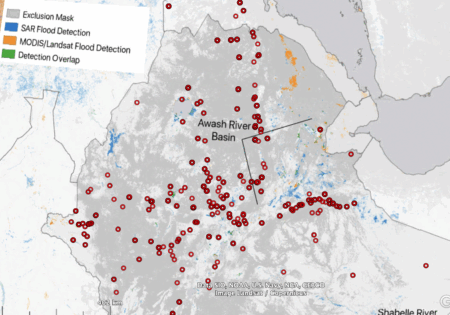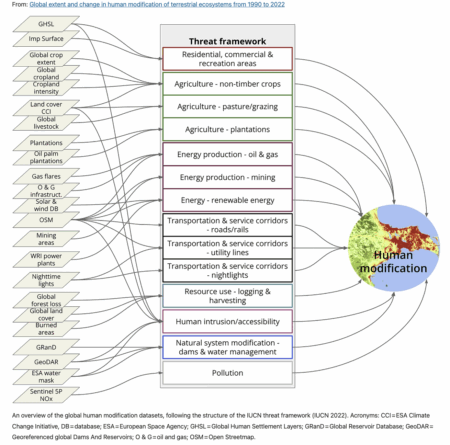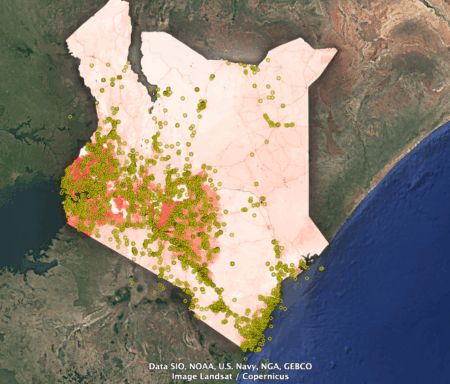- Consistent global dataset on biodiversity intactness footprint of agricultural production from 2000 to 2020. Spatial dataset shows how global consumption drives ecological degradation.
- Rapid monitoring of global land change. Spatial dataset shows how in 2023 direct human action and fires caused land use conversion globally over an area the size of California.
- Remote monitoring of plant drought stress with the apparent heat capacity. Spatial dataset can provide early warning of drought. Early warning system for genetic erosion, anyone?
- CropSuite v1.0 – a comprehensive open-source crop suitability model considering climate variability for climate impact assessment. Spatial dataset shows where 48 crops will have the best yields.
- Climate change increases the interannual variance of summer crop yields globally through changes in temperature and water supply. Spatial dataset shows that climate change impacts not just yields but variation in yield from year to year for maize, soybean and sorghum.
- Reassessing data management in increasingly complex phenotypic datasets. Datasets need to be properly managed to be widely used.
Brainfood: Taxonomic identification, Niche mapping, Harvest tracking, Drones, Phenomics, Yield analysis
- Review of herbarium plant identification of crop wild relatives using convolutional neural network models. Cool tech helps you figure out which species is which. Now you can map them properly I guess.
- Habitat prediction mapping for prioritizing germplasm collection areas of cowpea (Vigna unguiculata (L.) Walp) in India using BioClim model. Having mapped them, another cool tech helps you figure out where to collect them.
- Harvest Date Monitoring in Cereal Fields at Large Scale Using Dense Stacks of Sentinel-2 Imagery Validated by Real Time Kinematic Positioning Data. And when.
- Drone methods and educational resources for plant science and agriculture. In the field, cool tech could help you find and collect them. And not just that…
- Foliar disease resistance phenomics of fungal pathogens: image-based approaches for mapping quantitative resistance in cereal germplasm. Having collected them, more cool tech helps you evaluate them.
- Machine learning reveals drivers of yield sustainability in five decades of continuous rice cropping. Finally, having evaluated them over many years, cool tech helps you figure out what’s going on.
Before the flood
So, three years back, I posted about the floods in Pakistan, and how genebanks could potentially help farmers recover any crop diversity they lost because of them. But wouldn’t it be even better if the danger of flooding could be predicted? That way crop diversity from at-risk areas could be collected, if not already in genebanks, and multiplied up ready to be distributed should disaster strike.
Well, a recent paper does just that, using AI, no less: “We use our model predictions to identify historically flood-prone areas in Ethiopia and demonstrate real-time disaster response capabilities during the May 2024 floods in Kenya.”
I’ve managed to geo-reference a screen grab of the Ethiopia map provided in the paper using MapWarper, import it into Google Earth, and add the locations of sorghum landraces as reported in Genesys. Here’s what I got.
Unlike in the Pakistan example, there’s not much in the way of genebank accessions from areas of Ethiopia that are particularly at risk from flooding, it seems from this. However, Genesys does not (yet) include geographic provenance data for sorghum from the national genebank of Ethiopia. The 4000-odd sorghum accession from Ethiopia currently in Genesys are conserved at ICRISAT.
Brainfood: EcoregionsTreeFinder, Microbe niches, Herbarium phenology, Green Status Index of Species Recovery, Feral pigs, Trade & biodiversity, African cereal self-sufficiency, Plant protection, Ugandan seed systems, Grasspea breeding, Indigenous knowledge
- EcoregionsTreeFinder—A Global Dataset Documenting the Abundance of Observations of > 45,000 Tree Species in 828 Terrestrial Ecoregions. The right native tree for your ecoregion of choice. Which, given lots of the stuff below, is good to know. Oh, and BTW, there’s also the Agroforestry Species Switchboard.
- Modelling the distribution of plant-associated microbes with species distribution models. Would be cool to mash up with the above one day.
- The promise of digital herbarium specimens in large-scale phenology research. Something else you can use herbarium specimens for, if you’re careful.
- A global indicator of species recovery. The Green Status Index of Species Recovery, no less. Herbaria surely involved again.
- Valorization of feral pigs in the tropics, from the genetic characterization to the re- domestication. Wish there was a Green Status Index of Breed Recovery.
- Global staple food trade exacerbates biodiversity loss: a network perspective. Soybeans are messing with the Green Status Index of Species Recovery of lots of species, I suspect.
- Prospects for cereal self-sufficiency in sub-Saharan Africa. Prospects for self-sufficiency are not bad, but will require yield increases if the Green Status Index of Species Recovery is not going to take a hit.
- Protecting crops with plant diversity: Agroecological promises, socioeconomic lock-in, and political levers. Agroforestry and diverse landscapes are best for pest control, but cultivar mixtures are worth a try too. Wonder what they will do for cereal self-sufficiency in Africa. I lot, I bet, if given a chance.
- The dynamics of crop diversity and seed use in the context of recurrent climate shocks and poverty: Seasonal panel data evidence from rural Uganda. Farmers use crop diversity to cope with climate change, and wealthy farmers do it better. Pest control too, maybe?
- Understanding Farmer Preferences to Guide Crop Improvement: The Case of Grasspea in Ethiopia. Breeders should provide jam today and jam tomorrow.
- Crop diversity trends captured by Indigenous and local knowledge: introduction to the symposium. Indigenous and local knowledge can help you keep track of all of the above.
Modified ecosystems and the conservation of crop diversity
A new global assessment of the state of terrestrial ecosystems has just been published, focusing on the extent of human modification due to “industrial pressures based on agriculture, forestry, transportation, mining, energy production, electrical infrastructure, dams, pollution and human accessibility.” 1
As is my wont, I tried to find a form of the data that I could shoehorn into Google Earth, but I failed. Fortunately GIS guru Kai Sonder of CIMMYT was able to snip out a kml file of overall human transformation as of 2020 covering Kenya — don’t ask me how. But thanks, Kai. I put on top of it genebank accessions from Kenya classified as wild or weedy in Genesys.
I don’t know quite what to make of this. The wild populations seem to have been mainly collected in areas that in 2020 were very highly affected by human activity. But is that good or bad?
It could be good — in a sense — if the high degree of human transformation means that the original populations are not there any more. 2 Phew, good thing they were collected! On the other hand, it could be bad if the concentration on easily accessible and modified areas means that the genetic diversity currently being conserved is not representative of what’s out there.
What do you think?
But of course what I really want is a version of this which focuses on agricultural areas and is updated in real time. Yes, a perennial favourite here: a real early warning system for erosion of crop diversity.


